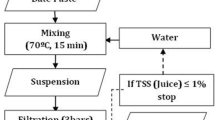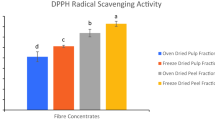Abstract
Palm press fibre (PPF) was obtained from two sources, a small-scale oil palm processing unit and a large-scale factory processing unit, and its chemical composition was determined. In vitro digestibility techniques were used to assess the feeding value of untreated, defatted and sodium hydroxide-treated PPF. For the NaOH treatment, 0.5 g oven-dried PPF was treated for 24 h with 5% NaOH in three ways: treated and not washed (NaNW); treated and washed (NaW); and treated after milling (NAD).
The results indicate that, on a dry matter basis, PPF is low in nitrogen (12–13 g/kg), moisture (37–90 g/kg) and ash (53–62 g/kg), but high in ether extract (269–355 g/kg), neutral detergent fibre (532–768 g/kg), acid detergent fibre (375–548 g/kg) and lignin (219 g/kg). The in vitro dry matter digestibility values were low for the samples from both sources, but the large-scale factory-processed PPF had higher in vitro dry matter digestibility (0.215 vs 0.166) and in vitro organic matter digestibility (0.196 vs 0.145). Defatting the PPF and treating it with 5% NaOH solution significantly (p<0.01) improved both the dry matter and organic matter digestibility. Washing the NaOH-treated PPF resulted in a higher digestibility of dry matter as against NaNW or NAD. These results suggest that defatting and treatment with 5% NaOH would improve the feeding value of PPF.
Similar content being viewed by others
REFERENCES
AOAC, 1990. Official Methods of Analysis, 15th edn, (Association of Official Analytical Chemists, Washington DC)
Chaudhry, A.S., 1997. Washing and filtration of wheat straw treated with sodium hydroxide alone or with hydrogen peroxide to modify cell wall composition and to improve in vitro digestibility. Australian Journal of Experimental Agriculture, 37, 617-621
Chaudhry, A.S. and Miller, E.L., 1996. The effect of sodium hydroxide and alkaline hydrogen peroxide on chemical composition of wheat straw and voluntary intake, growth and digesta kinetics in store lambs. Animal Feed Science Technology, 60, 69-86
Dehority, B.A., Johnson, R.R. and Conrad, H.R., 1962. The effect of lignin on the digestibility of feeds in ruminants. Journal of Dairy Science, 45, 508-512
Devendra, C., 1978. Utilization of feeding stuffs from the oil palm. In: C. Devendra and R.I. Hutagalung (eds), Feeding Stuffs for Livestock in South East Asia, (Malaysian Society of Animal Production, Kuala Lumpur), 116-139
Goering, H.K. and Van Soest, P.J., 1970. Forage Fibre Analysis (apparatus, reagents, procedures and some applications), (Agricultural Handbook, USDA No. 3793; United States Department of Agriculture, Washington DC)
Hutagalung, R.T., 1981. The use of tree crops and their by-products for intensive animal production. In: Intensive Animal Production in Developing Countries, (Occasional publication No. 4; British Society of Animal Production), 156-174
Jelan, Z.A., Jalaludin, S. and Vijchulata, P., 1986. In: Isotope Aided Studied on Non-protein Nitrogen and Agro-industrial By-products Utilization by Ruminants, (Proceedings of the International Atomic Energy Agency,Vienna), 73-87
Jung, H.G., Buxton, D.R., Hatfield, R.D. and Ralph, J., 1993. Forage Cell Wall Structure and Digestibility, (American Society for Agronomics, Wisconsin)
Leng, R.A., 1992. Drought Feeding Strategies: Theory and Practice, (University of New England Printery, Penambul Books, Armidale, New SouthWales), 86-106
Lesoing, G., Klopfenstein, T., Rush, I. and Ward, J. 1981. Chemical treatment of wheat straw. Journal of Animal Science, 51, 263-269
MacDonald, P., Edwards, R.A. and Greenhalgh, J.F.D., 1988. Animal Nutrition, 4th edn, (Longman Scientific and Technical, Harlow), 1-157
Orskov, E.R. and Ryle, M., 1990. Energy Nutrition in Ruminants, (Elsevier Science Publishers Ltd., England), 10-121
Steel, R.G. and Torrie, J.H., 1980. Principles and Procedures of Statistics, 2nd edn, (McGraw-Hill, New York)
Tilley, J.W. and Terry, R.A., 1963. A two-stage technique for the in vitro digestion of forage crops. Journal of the British Grassland Society, 18, 104-111
Vadiveloo, J. and Fadel, J.G., 1992. Compositional analyses and rumen degradability of selected tropical feeds. Animal Feed Science and Technology, 37, 265-279
Van Soest, P.J., 1994. Nutritional Ecology of the Ruminant, 2nd edn, (Cornell University Press, New York), 177-195
Wan Mohammed, W.E., Hutagalung, R.I. and Chen, C.P., 1987. Advances in animal feeds and feeding in the tropics. Proceedings of the 10th Annual Conference of the Malaysian Society of Animal Production, Genting Highlands, 81
Author information
Authors and Affiliations
Rights and permissions
About this article
Cite this article
Obese, F., Osafo, E. & Okai, D. Evaluation of the Feeding Value of Palm Press Fibre Using In Vitro Digestibility Techniques. Tropical Animal Health and Production 33, 165–172 (2001). https://doi.org/10.1023/A:1005293732378
Issue Date:
DOI: https://doi.org/10.1023/A:1005293732378




